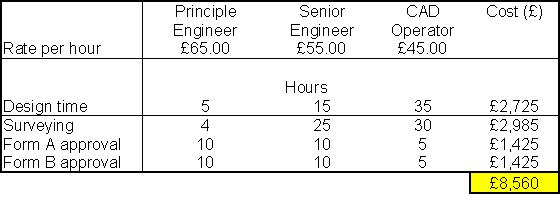This website has been archived from TrainWeb.org/railengineering to TrainWeb.US/railengineering.
|
Home
Estimating
Vehicle Systems Design
|
Estimating
I spent the first day finding out what goes into he procedure of estimating the cost of a
design job. The specific job in question was the design of a freight line at Humberside
docks.
This is a private siding for the Association of British Ports (ABP). Corus had designed the
job for ABP, and they were happy with the projected costs for design. However, since the
freight terminal has to join the existing rail network, Railtrack decided to overtake the
entire project. Railtrack added more cost to the entire job for aspects of project
management. ABP are not too happy about the additional cost and are therefore complaining
to the government about Railtracks performance.
I feel that this is poor management of a project. Railtrack have to think about their position
as the infrastructure owner. I feel that they cannot come in and take over a project without
thinking about all possibilities and others' perspective. As a result of doing so, they seem
to have put themselves in an unfavourable position with respect to other companies views.
So, as a result, Corus have been asked to produce two sets of designs; one for Railtrack and
one for ABP. It was the costing estimate for Railtrack that I witnessed being produced.
An engineer will input all projected costs into a Microsoft Excel spreadsheet. Firstly,
the engineer has to think about all the process involved in a design. This will include
design time, design approvals, surveying and studies.
There would also be a list of job titles, for example, principle engineer, senior engineer,
engineer and CAD operators. Hours for each task in the design would then be allocated to
each person listed. The hours would be multiplied by the hourly rate.
To emphasise how this might work, a simplified example is shown below. As seen in Fig 61,
numbers are generalised, but the way it works can clearly be seen.
 Also included would be disbursements. These cover everything from car hire to hotels and evening meals. The cost of the job is then forwarded to the client, and if the client thinks that it is too expensive, negotiations begin. That is if the contract was of a fixed basis. Sometimes, contracts can go for a competitive tender, where several companies can submit a cost for the same job. The client can then choose the contractor for the job. Work can be done for a client under different contracts. This depends upon what is wanted by both parties and is clarified in the brief. Fixed rate contract This is where the client asks for a price for completion of the job, start to finish. The client would be expecting to pay what was originally estimated, with a tolerance of ± 10%. Time related contract This is the type of contract were the client is charged for the actual work done, for example, by the hour. How far the contractor proceeds with the job is irrelevant.
|














